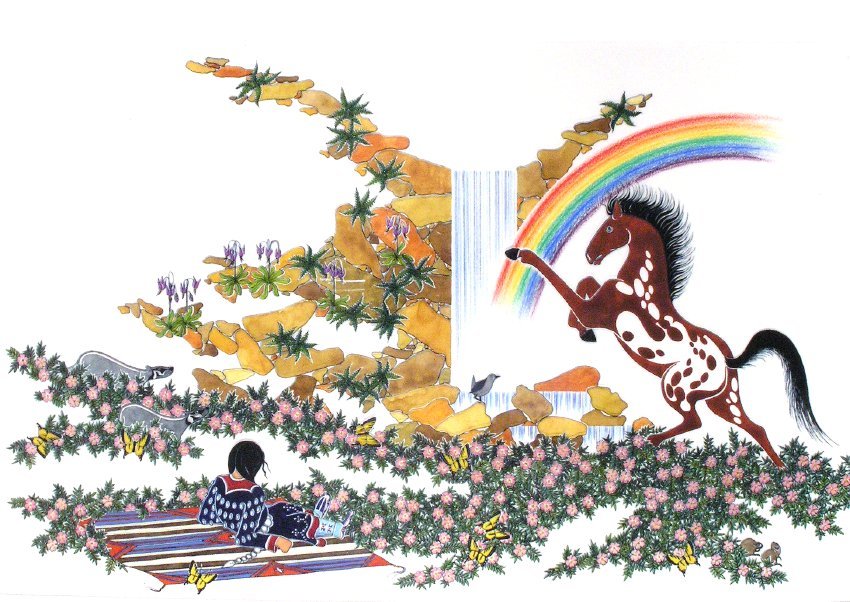Children’s book author and illustrator Paul Goble is known for his retellings of Plains American Indian stories. The tradition of American Indian storytelling on the Plains is a fusion of artistry, entertainment and higher purpose, where important cultural, spiritual and familial lessons are intertwined. The illustrations on display are drawn from stories which reveal that relatives are much more than one’s connections by birth or marriage.
"The Girl Who Loved Wild Horses" is a story of transformative acts of love between man and animal. This relationship between man and animal is also highlighted in "Adopted by the Eagles," a story in which such interdependent bonds provide protection and salvation when human trust fails. Other stories, like "Star Boy," feature the marriage of a human with the natural world which ultimately brings transformation and healing to the community. "Her Seven Brothers" tells another story of transformation, underlining the value of unity through adversity, memorializing the family’s chosen bond in the story’s final image. These stories ultimately reveal that making relatives can provide security, salvation and a sense of belonging.
Also included in the exhibition is a beaded frame by Jim Little Wounded (Oglala Lakota), which Goble owned and featured in "Adopted by the Eagles." In the Goble home, the frame displayed a photograph of Chief Edgar Red Cloud.
The books these illustrations are drawn from are available for reference in the gallery and for purchase in the Museum Store.
Author and illustrator Paul Goble was born in England on Sept. 27, 1933. He grew up in a family where art and literature were valued and promoted. He also grew up with a deep fascination for the indigenous peoples of North America. As a young man he made several visits to the United States to spend time in reservations in South Dakota and Montana. He moved to the Black Hills of South Dakota permanently in 1977 and became an American citizen in 1984.
Throughout his career, Goble garnered countless awards for his writing and artwork. In 1979 he received the Caldecott Medal, which is one of the most prestigious awards in all of children’s literature. Goble’s Caldecott winner, "The Girl Who Loved Wild Horses", is just one of over 40 books in a career extending back to his first title, "Red Hawk’s Account of Custer’s Last Battle," published in 1969. Throughout his long career, Goble focused on Plains American Indian history and retellings of traditional American Indian stories.
Goble recognized the issue of an Englishman recording the cultural heritage of American Indians. However, his intentions were clear when he stated, “The myths that I am retelling are not Tolkien-like stories to entertain, but are like Bible stories, parables, which hold real truths at different levels. They are a part of the Native American tradition, part of this land.” Award-winning Lakota author and illustrator S.D. Nelson says, “Paul Goble has a good heart. His paintings and his storytelling honor Lakota ways. Paul Goble, with his artistic insights, has shared our Lakota tradition and spiritual teachings with the world in a positive way. He is a true friend of our people.” Like Nelson, world-renowned Lakota flute player and hoop dancer, Kevin Locke, is an enrolled member of the Standing Rock Sioux Tribe. In a letter to Goble Locke once wrote, “You’ve done more to heighten an awareness of our culture than just about anyone I can think of.”
Paul Goble passed away on Jan. 5, 2017. The primary resource for access to works representative of his career is in Brookings at the South Dakota Art Museum. The museum’s extensive Paul Goble Collection consists of over 500 watercolor, gouache, and ink illustrations.











